How to uninstall unwanted apps from computers?
Potentially unwanted applicationAlso Known As: Social Security Account Update scam
Get free scan and check if your device is infected.
Remove it nowTo use full-featured product, you have to purchase a license for Combo Cleaner. Seven days free trial available. Combo Cleaner is owned and operated by RCS LT, the parent company of PCRisk.com.
What kind of scam is "Social Security Account Update"?
We have examined the email and found it is a deceptive message disguised as a Social Security account update notification. It contains a link designed to download an installer that security vendors flag as malicious. Falling for this scam can cause security and privacy issues.
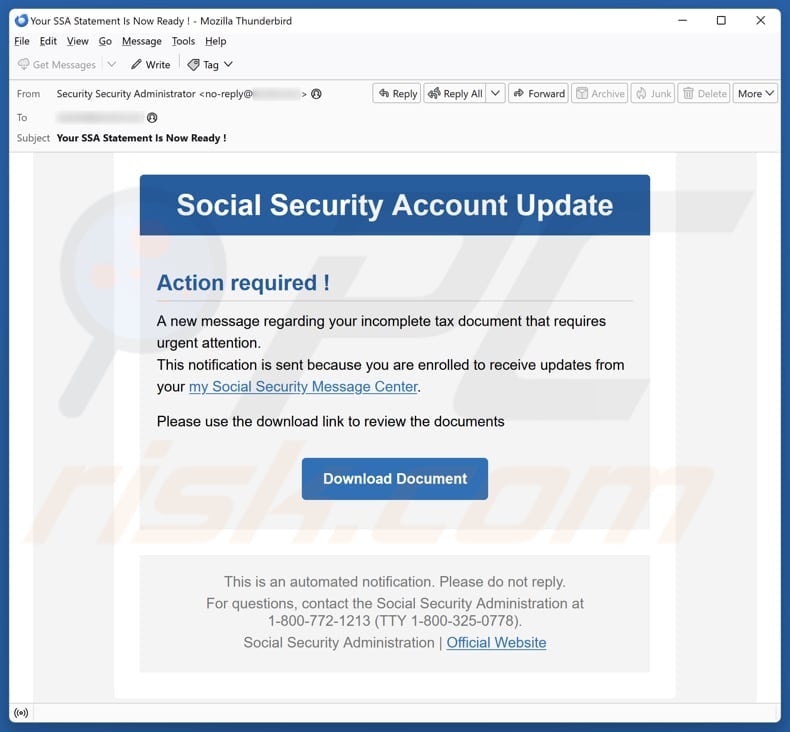
"Social Security Account Update" email scam overview
This scam email claims to be from the Social Security Administration and informs the recipient that their SSA statement is ready. It says that an incomplete tax document requires urgent attention and claims that the message was sent because the recipient is enrolled to get updates from the Social Security Message Center.
The email instructs the recipient to click the download link ("Download Document") to review the document. However, there is no actual document, and the provided link downloads an installer that seems to install the Atera agent (software that lets IT professionals monitor and manage devices remotely, collecting system health, performance, and security data for analysis).
However, several security vendors have detected the downloaded installer as malicious, suggesting it is likely a fake or compromised version rather than the legitimate Atera agent. This could mean the file is malware designed to steal information or take control of the system once installed.
It could also function as adware, a browser hijacker, or other unwanted software. Either way, it is highly advisable not to install the provided app to avoid issues like computer infections, unwanted ads, financial loss, identity theft, account hijacking, or other negative outcomes.
| Name | Social Security Account Update scam |
| Threat Type | Potentially malicious application |
| Detection Names (Installer) | CTX (Msi.remote-access-trojan.atera), Fortinet (Riskware/Atera), Kaspersky (Not-a-virus:HEUR:RemoteAdmin.MSIL.Atera.gen), Kingsoft (Win32.HACKTOOL.RemoteAdmin.v), Full List Of Detections (VirusTotal) |
| Detection Names (Application) | AliCloud (Backdoor[rat]:MSIL/Atera.gyf), DrWeb (Program.RemoteAdminNET.1), Fortinet (Riskware/Atera), Kaspersky (Not-a-virus:HEUR:RemoteAdmin.MSIL.Atera.gen), VBA32 (Riskware.MSIL.AteraAgent.gen), Full List Of Detections (VirusTotal) |
| Symptoms | Slow performance, unwanted pop-up ads, unexpected redirects to unfamiliar websites, changes in browser settings, and the presence of unfamiliar programs. |
| Distribution Methods | |
| Possible Damage | Computer infections, privacy issues, monetary loss, account hijacking, identity theft |
| Malware Removal (Windows) |
To eliminate possible malware infections, scan your computer with legitimate antivirus software. Our security researchers recommend using Combo Cleaner. Download Combo CleanerTo use full-featured product, you have to purchase a license for Combo Cleaner. 7 days free trial available. Combo Cleaner is owned and operated by RCS LT, the parent company of PCRisk.com. |
Conclusion
Overall, this is a scam designed to trick recipients into downloading a malicious installer disguised as legitimate software. Installing it could lead to malware infection, data theft, or other serious security and privacy risks. It is strongly advised to ignore the email and avoid downloading the file.
Some examples of other scam emails are "Expiration Notification", "E-mail Administrator", and "Domiciliary Bank Account".
How did unwanted applications install on my computer?
Typically, unwanted apps infiltrate systems through unofficial websites or app stores, deceptive advertisements, P2P networks, third-party downloaders, and similar channels. Our analysis of the scam email shows that emails are also sometimes used to trick users into installing unwanted (and potentially malicious) applications.
Additionally, unwanted apps can be installed through software bundles. When users install free or shady programs, they may unknowingly agree to install additional apps by leaving the included settings (e.g., "Advanced" or "Manual") unchanged.
How to avoid installation of unwanted applications?
Download applications from official sites or app stores. Avoid installing pirated programs or using cracking tools and key generators. Do not interact with ads and links found on suspicious websites and avoid agreeing to receive notifications from websites of this kind. Regularly update the operating system and installed apps.
Be careful with suspicious emails from unknown senders - do not open links or files in emails (or other messages) of this kind. Also, regularly scan your computer for threats using a reputable security tool. If your computer is already infected with rogue apps, we recommend running a scan with Combo Cleaner Antivirus for Windows to automatically eliminate them.
Text in the scam email:
Subject: Your SSA Statement Is Now Ready !
Social Security Account Update
Action required !A new message regarding your incomplete tax document that requires urgent attention.
This notification is sent because you are enrolled to receive updates from your my Social Security Message Center.Please use the download link to review the documents
Download Document
This is an automated notification. Please do not reply.
For questions, contact the Social Security Administration at 1-800-772-1213 (TTY 1-800-325-0778).
Social Security Administration | Official Website
Installation folder of the distributed app:
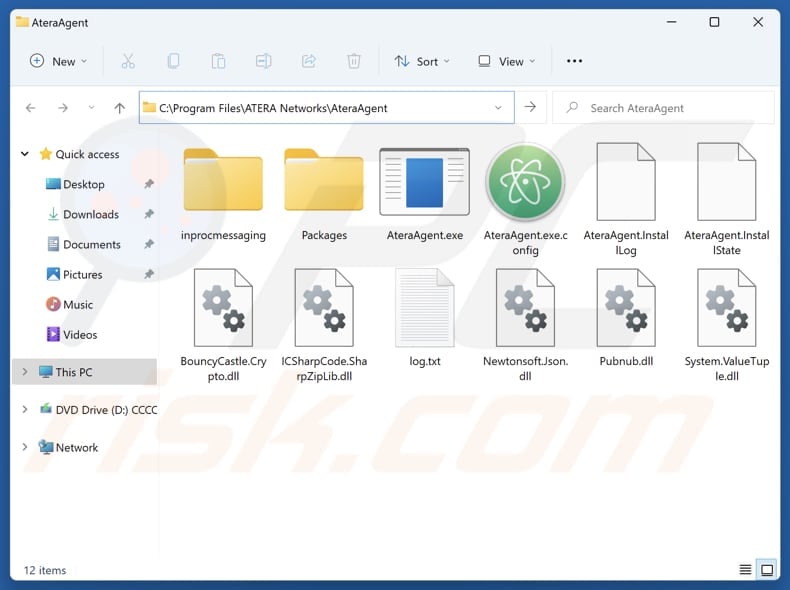
Instant automatic malware removal:
Manual threat removal might be a lengthy and complicated process that requires advanced IT skills. Combo Cleaner is a professional automatic malware removal tool that is recommended to get rid of malware. Download it by clicking the button below:
DOWNLOAD Combo CleanerBy downloading any software listed on this website you agree to our Privacy Policy and Terms of Use. To use full-featured product, you have to purchase a license for Combo Cleaner. 7 days free trial available. Combo Cleaner is owned and operated by RCS LT, the parent company of PCRisk.com.
Quick menu:
- What is Social Security Account Update scam?
- STEP 1. Uninstall deceptive applications using Control Panel.
- STEP 2. Remove rogue extensions from Google Chrome.
- STEP 3. Remove potentially unwanted plug-ins from Mozilla Firefox.
- STEP 4. Remove rogue extensions from Safari.
- STEP 5. Remove rogue plug-ins from Microsoft Edge.
Removal of unwanted applications:
Windows 11 users:
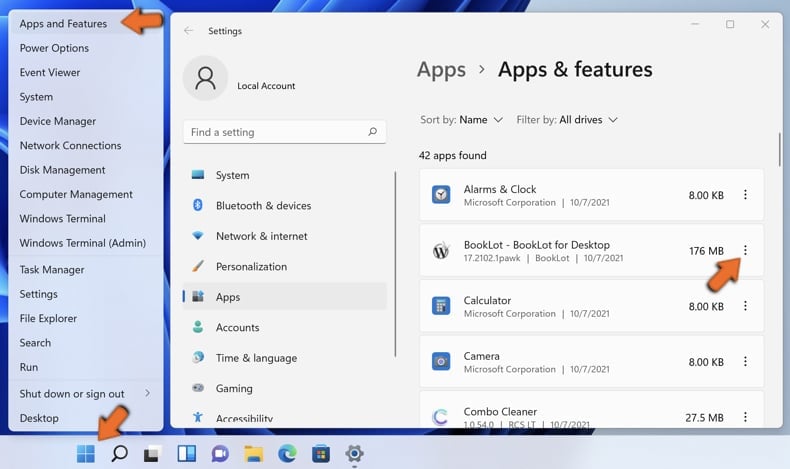
Right-click on the Start icon, select Apps and Features. In the opened window search for the application you want to uninstall, after locating it, click on the three vertical dots and select Uninstall.
Windows 10 users:
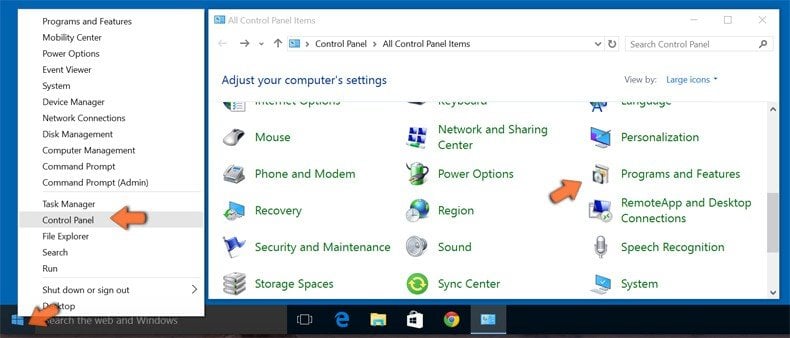
Right-click in the lower left corner of the screen, in the Quick Access Menu select Control Panel. In the opened window choose Programs and Features.
Windows 7 users:
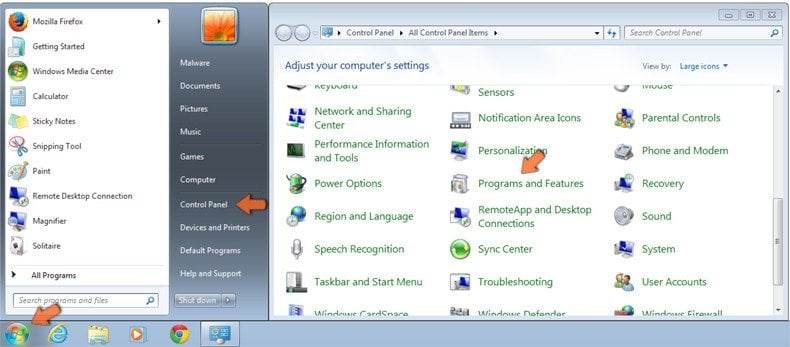
Click Start (Windows Logo at the bottom left corner of your desktop), choose Control Panel. Locate Programs and click Uninstall a program.
macOS (OSX) users:
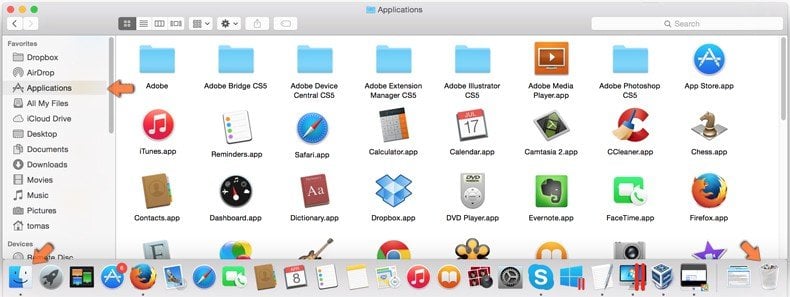
Click Finder, in the opened screen select Applications. Drag the app from the Applications folder to the Trash (located in your Dock), then right click the Trash icon and select Empty Trash.
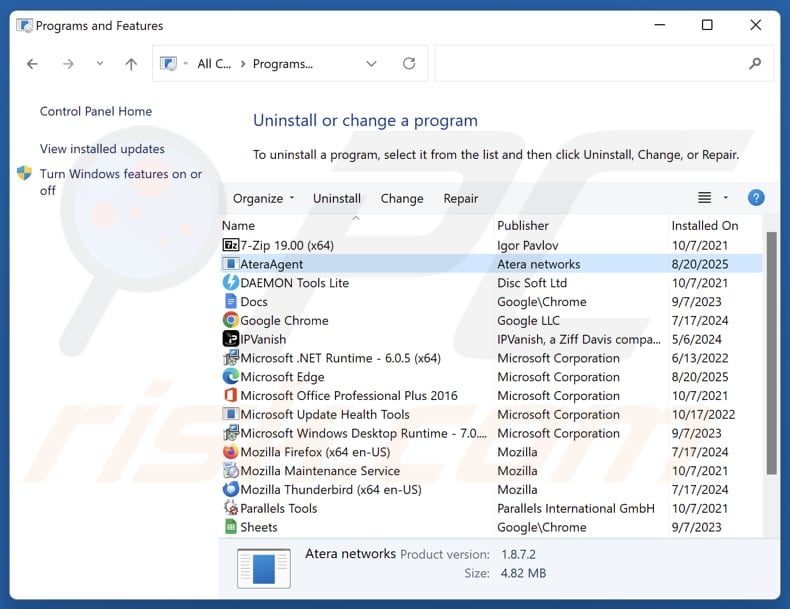
In the uninstall programs window, look for suspicious applications (e.g., "AteraAgent"), select these entries and click "Uninstall" or "Remove".
After uninstalling the potentially unwanted application, scan your computer for any remaining unwanted components or possible malware infections. To scan your computer, use recommended malware removal software.
DOWNLOAD remover for malware infections
Combo Cleaner checks if your computer is infected with malware. To use full-featured product, you have to purchase a license for Combo Cleaner. 7 days free trial available. Combo Cleaner is owned and operated by RCS LT, the parent company of PCRisk.com.
Remove rogue extensions from Internet browsers:
At time of research, setup promoted via "Social Security Account Update" email scam did not install any unwanted browser extensions, however, some unwanted applications can be installed together with adware and browser hijackers. If you experience unwanted ads or redirects when browsing the Internet, continue with the removal guide below.
Video showing how to remove potentially unwanted browser add-ons:
 Remove malicious extensions from Google Chrome:
Remove malicious extensions from Google Chrome:

Click the Chrome menu icon ![]() (at the top right corner of Google Chrome), select "Extensions" and click "Manage Extensions". Locate all recently-installed suspicious extensions, select these entries and click "Remove".
(at the top right corner of Google Chrome), select "Extensions" and click "Manage Extensions". Locate all recently-installed suspicious extensions, select these entries and click "Remove".
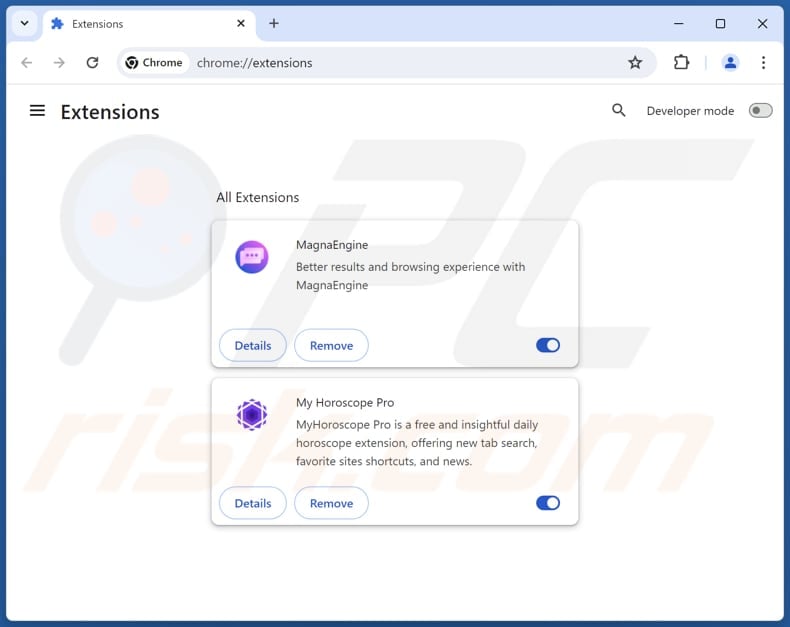
Optional method:
If you continue to have problems with removal of the social security account update scam, reset your Google Chrome browser settings. Click the Chrome menu icon ![]() (at the top right corner of Google Chrome) and select Settings. Scroll down to the bottom of the screen. Click the Advanced… link.
(at the top right corner of Google Chrome) and select Settings. Scroll down to the bottom of the screen. Click the Advanced… link.
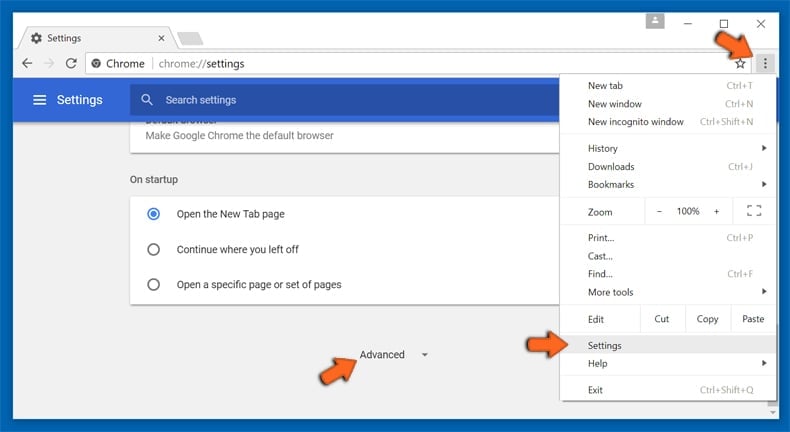
After scrolling to the bottom of the screen, click the Reset (Restore settings to their original defaults) button.
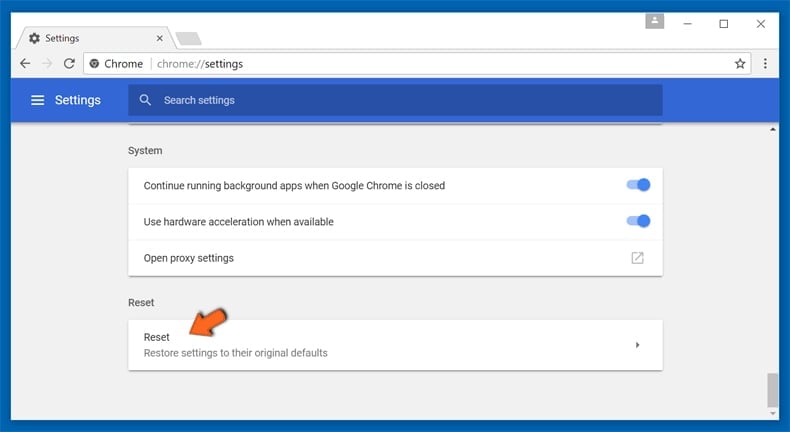
In the opened window, confirm that you wish to reset Google Chrome settings to default by clicking the Reset button.
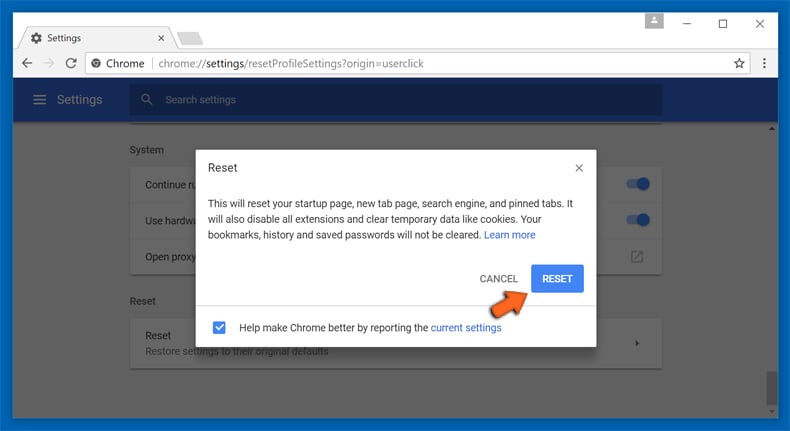
 Remove malicious plugins from Mozilla Firefox:
Remove malicious plugins from Mozilla Firefox:

Click the Firefox menu ![]() (at the top right corner of the main window), select "Add-ons and themes". Click "Extensions", in the opened window locate all recently-installed suspicious extensions, click on the three dots and then click "Remove".
(at the top right corner of the main window), select "Add-ons and themes". Click "Extensions", in the opened window locate all recently-installed suspicious extensions, click on the three dots and then click "Remove".
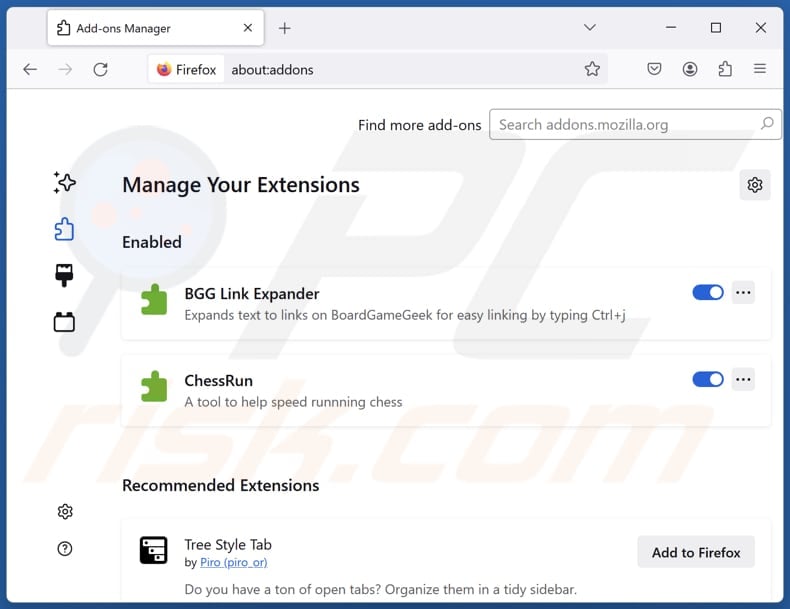
Optional method:
Computer users who have problems with social security account update scam removal can reset their Mozilla Firefox settings.
Open Mozilla Firefox, at the top right corner of the main window, click the Firefox menu, ![]() in the opened menu, click Help.
in the opened menu, click Help.
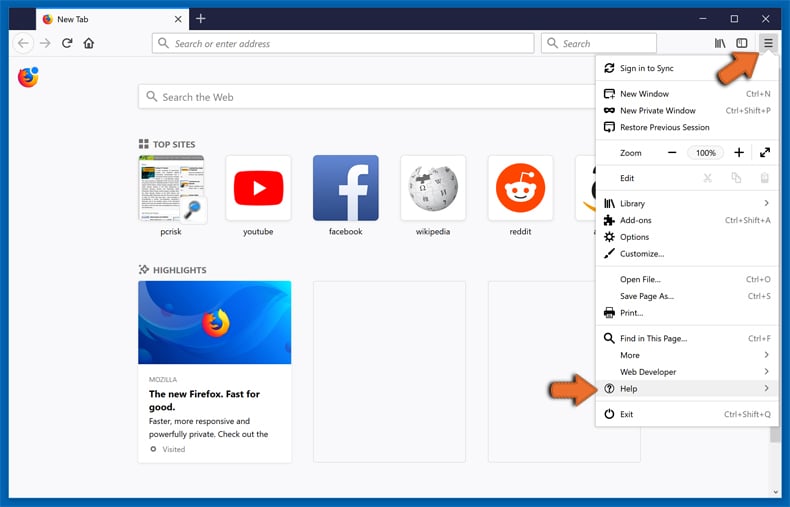
Select Troubleshooting Information.
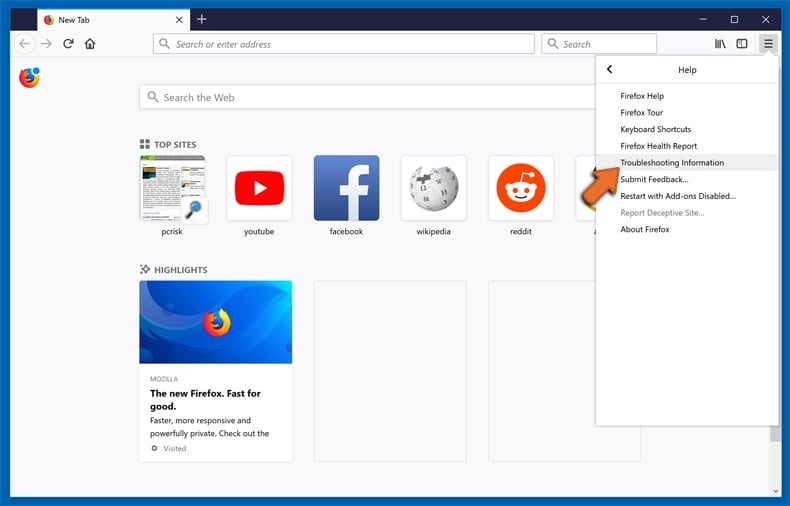
In the opened window, click the Refresh Firefox button.
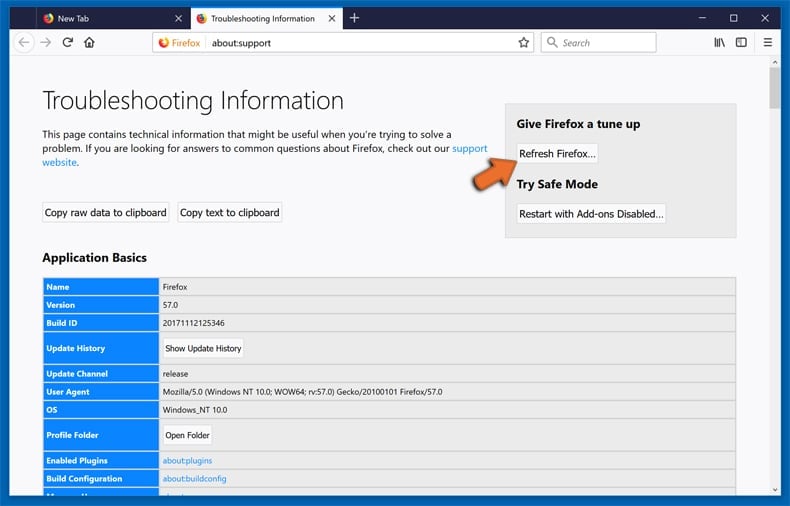
In the opened window, confirm that you wish to reset Mozilla Firefox settings to default by clicking the Refresh Firefox button.
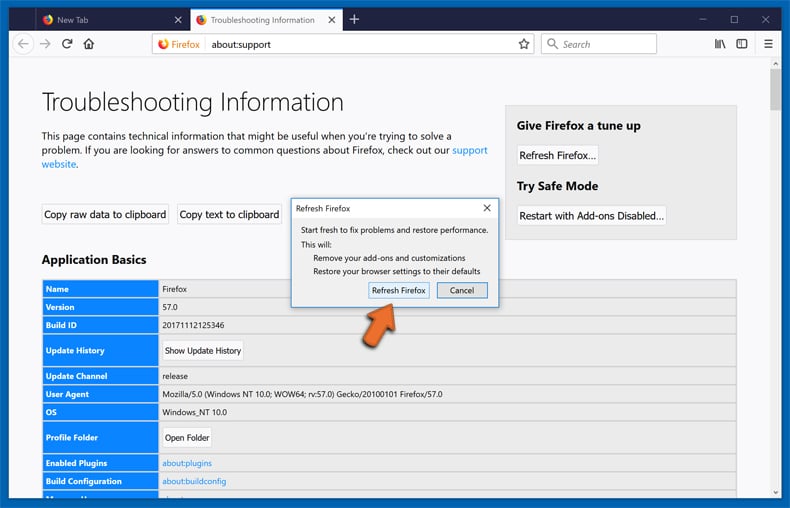
 Remove malicious extensions from Safari:
Remove malicious extensions from Safari:
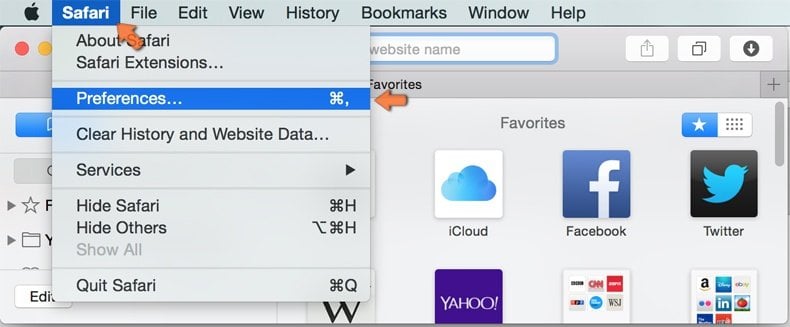
Make sure your Safari browser is active, click Safari menu, and select Preferences....
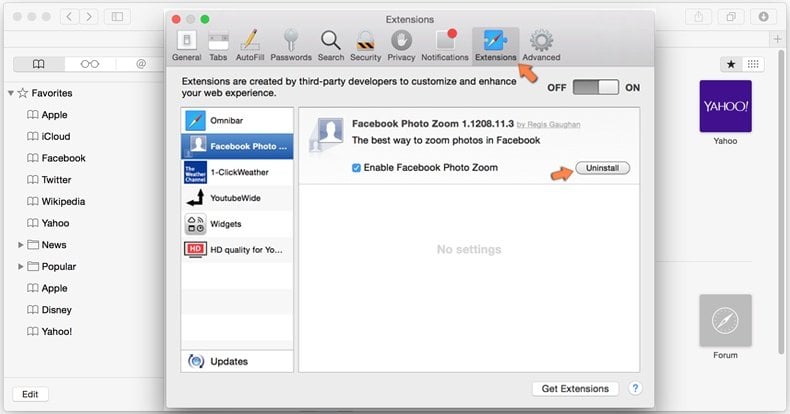
In the opened window click Extensions, locate any recently installed suspicious extension, select it and click Uninstall.
Optional method:
Make sure your Safari browser is active and click on Safari menu. From the drop down menu select Clear History and Website Data...
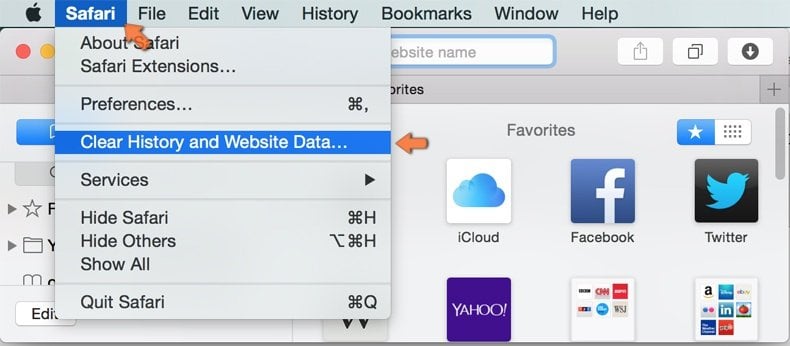
In the opened window select all history and click the Clear History button.
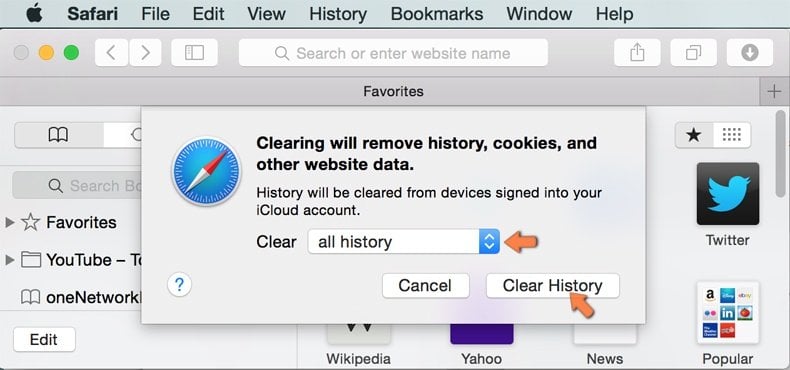
 Remove malicious extensions from Microsoft Edge:
Remove malicious extensions from Microsoft Edge:
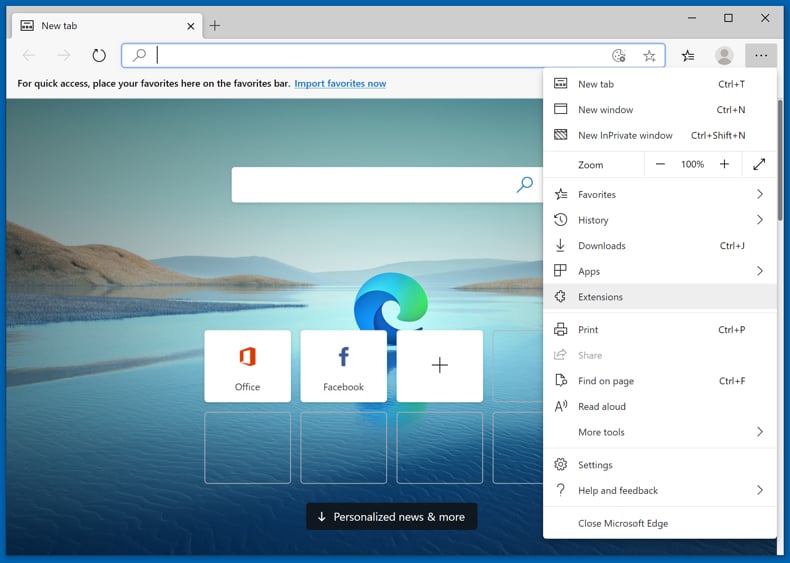
Click the Edge menu icon ![]() (at the upper-right corner of Microsoft Edge), select "Extensions". Locate all recently-installed suspicious browser add-ons and click "Remove" below their names.
(at the upper-right corner of Microsoft Edge), select "Extensions". Locate all recently-installed suspicious browser add-ons and click "Remove" below their names.

Optional method:
If you continue to have problems with removal of the social security account update scam, reset your Microsoft Edge browser settings. Click the Edge menu icon ![]() (at the top right corner of Microsoft Edge) and select Settings.
(at the top right corner of Microsoft Edge) and select Settings.
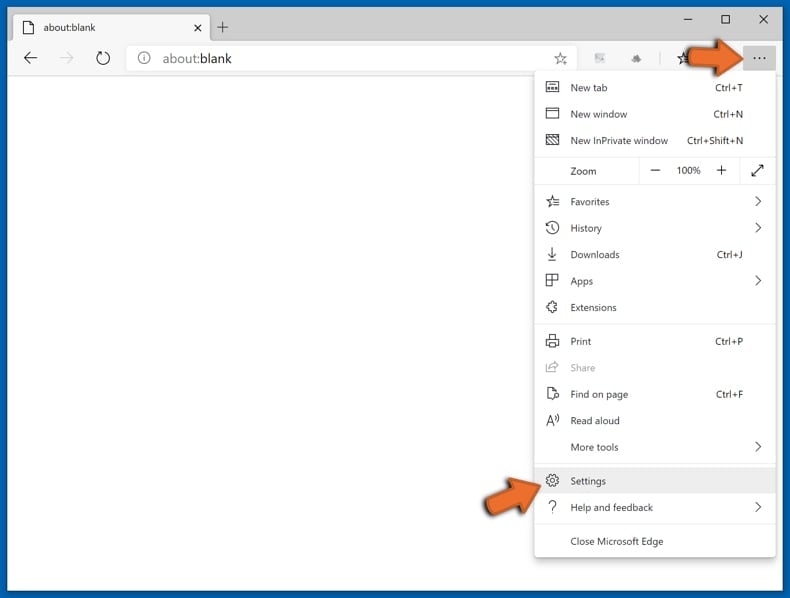
In the opened settings menu select Reset settings.
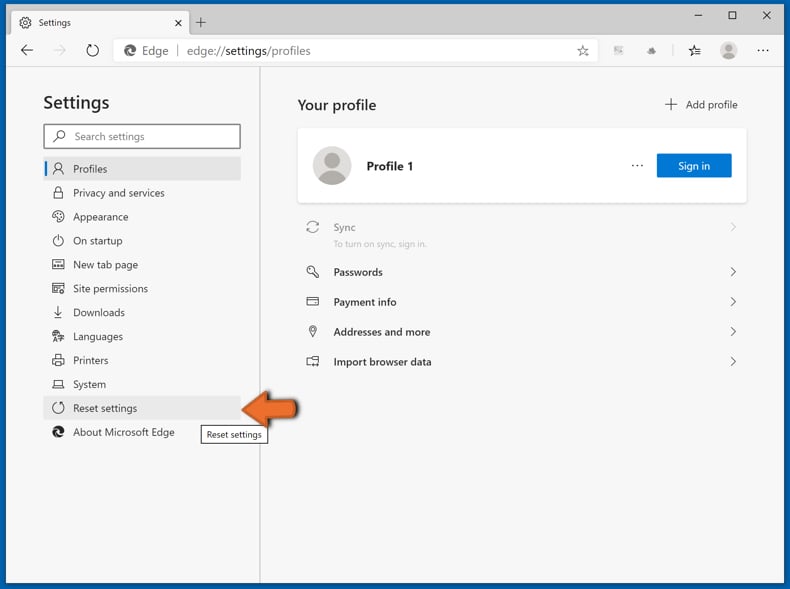
Select Restore settings to their default values. In the opened window, confirm that you wish to reset Microsoft Edge settings to default by clicking the Reset button.
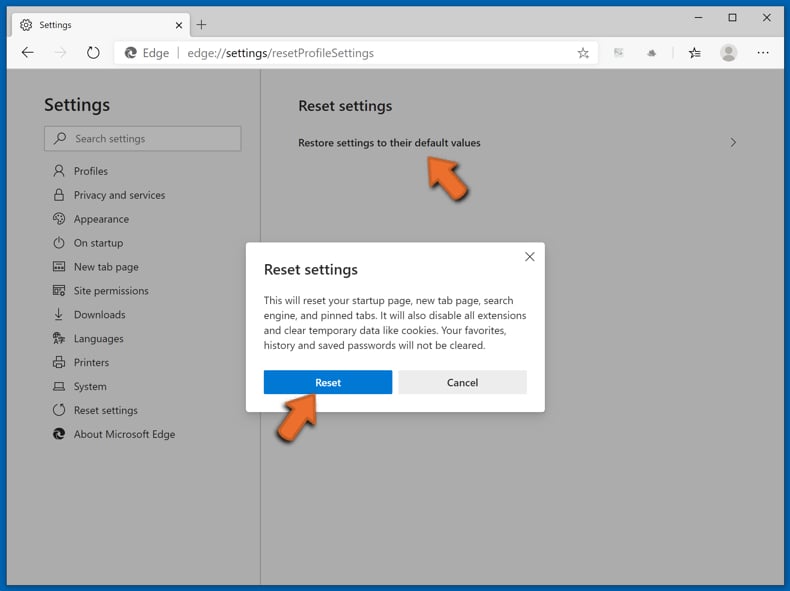
- If this did not help, follow these alternative instructions explaining how to reset the Microsoft Edge browser.
Summary:
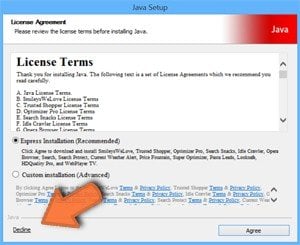 Commonly, adware or potentially unwanted applications infiltrate Internet browsers through free software downloads. Note that the safest source for downloading free software is via developers' websites only. To avoid installation of adware, be very attentive when downloading and installing free software. When installing previously-downloaded free programs, choose the custom or advanced installation options – this step will reveal any potentially unwanted applications listed for installation together with your chosen free program.
Commonly, adware or potentially unwanted applications infiltrate Internet browsers through free software downloads. Note that the safest source for downloading free software is via developers' websites only. To avoid installation of adware, be very attentive when downloading and installing free software. When installing previously-downloaded free programs, choose the custom or advanced installation options – this step will reveal any potentially unwanted applications listed for installation together with your chosen free program.
Post a comment:
If you have additional information on social security account update scam or it's removal please share your knowledge in the comments section below.
Frequently Asked Questions (FAQ)
Why did I receive this email?
Scam emails are usually sent to large number of addresses collected from data breaches, leaked databases, or fake websites. They are generally not personalized and do not target specific individuals.
I have downloaded and opened a malicious file sent via this email, is my computer infected?
It is unknown what the fake Atera agent installer's actual purpose is, but it could be used to deliver malware or other unwanted software. Thus, if you have installed the app, your computer may be infected.
I have read an email but did not open the downloaded file, is my computer infected?
Deceptive emails cannot cause damage unless recipients open infected files or links (and often take additional actions).
Will Combo Cleaner remove malware infections that were present in the email?
Combo Cleaner can detect and remove most known malware. Because advanced threats often hide deep in the system, performing a full system scan is strongly recommended.
Share:

Tomas Meskauskas
Expert security researcher, professional malware analyst
I am passionate about computer security and technology. I have an experience of over 10 years working in various companies related to computer technical issue solving and Internet security. I have been working as an author and editor for pcrisk.com since 2010. Follow me on Twitter and LinkedIn to stay informed about the latest online security threats.
PCrisk security portal is brought by a company RCS LT.
Joined forces of security researchers help educate computer users about the latest online security threats. More information about the company RCS LT.
Our malware removal guides are free. However, if you want to support us you can send us a donation.
DonatePCrisk security portal is brought by a company RCS LT.
Joined forces of security researchers help educate computer users about the latest online security threats. More information about the company RCS LT.
Our malware removal guides are free. However, if you want to support us you can send us a donation.
Donate
▼ Show Discussion